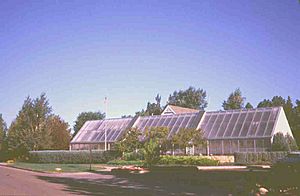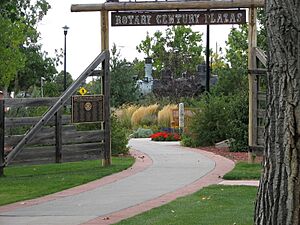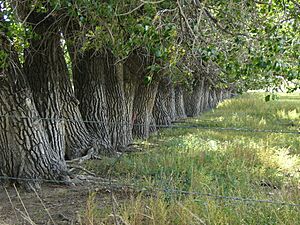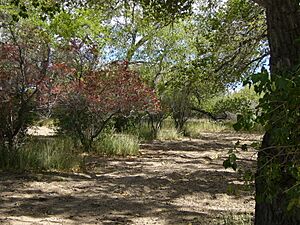Cheyenne Botanic Gardens facts for kids
Quick facts for kids Cheyenne Botanic Gardens |
|
|---|---|

Solar Conservatory
|
|
| Lua error in Module:Location_map at line 420: attempt to index field 'wikibase' (a nil value). | |
| Location | 710 S. Lions Park Drive Cheyenne, Wyoming 82001 |
The Cheyenne Botanic Gardens is a special place in Cheyenne, Wyoming. It covers about 9 acres (3.6 hectares) inside Lions Park. There's also a related area called the High Plains Arboretum, located a bit outside Cheyenne. This arboretum is about five miles (8 km) northwest of the city, high up at 6,200 feet (1,890 m) above sea level.
The idea for these gardens started in 1977. People wanted to build a greenhouse that used only solar power. Today, the main building, called the conservatory, is 6,800 square feet (630 m²) and has three greenhouses. One greenhouse is full of amazing tropical plants, herbs, and cacti. It even has a waterfall pond with colorful Koi fish. Another greenhouse is used to grow vegetables. The third one helps grow young plants and flowers for the gardens and for all the parks in Cheyenne. Outside, you'll find many different gardens with beautiful flowers and cacti.
Contents
A Special Place: Cheyenne Botanic Gardens
Dealing with Tough Weather
The Cheyenne Botanic Gardens faces some of the toughest weather in the United States. Cheyenne often gets hail storms, about 10 each year! It's also one of the windiest cities, with an average daily wind speed of 13 mph (21 km/h). Even though it's in the Rocky Mountains, it doesn't get much snow cover in winter. Being at 6,000 feet (1,829 m) means cooler nights, which can make it hard for plants to grow big. Plus, spring and fall frosts can happen unexpectedly.
Power from the Sun
Despite the challenging weather, the conservatory is 100% heated by the sun! Also, half of its electricity comes from solar power. This makes the Cheyenne Botanic Gardens one of the oldest and largest public places in the western U.S. to show how renewable energy works.
Awards and Recognition
The gardens have won many awards. These awards are mostly for their amazing volunteer programs and their use of renewable energy. Three different U.S. Presidents—Ronald Reagan, George H. W. Bush, and Bill Clinton—have given awards to the gardens. The person who started the gardens, Shane Smith, also received a special award from Harvard and a "Community Hero" award from former Governor of Wyoming, Jim Geringer.
The Founder of the Gardens
Shane Smith is the founding director of the Cheyenne Botanic Gardens. He planted the very first seed in 1977 and has been guiding the project ever since. Shane Smith also wrote a book called Greenhouse Gardener's Companion. He works as a greenhouse expert, giving talks and advice about greenhouse gardening, making communities greener, and using plants to help people feel better (called horticulture therapy). He has shared his knowledge in over 27 states and 3 countries. He also has a regular radio show in Cheyenne.
The Cheyenne Botanic Gardens is special because it has many more volunteers than paid staff. Over 90% of the work is done by senior citizens, young people, and volunteers with disabilities. Using plants to help people (horticultural therapy) is a big part of what happens at the gardens every day.
Designing the Gardens
The main plan and many designs for the Cheyenne Botanic Gardens were created by a talented landscape architect named Herbert R. Schaal. He is known for designing public botanical gardens and arboretums, especially children's gardens.
A special arch called the "moon arch" is located between the Peace Garden and the Garden Labyrinth. It is dedicated to Edwina Wiederspahn, who was married to a local leader.
The gardens have many different areas to explore. These include a beautiful rose garden, an herb garden, a Peace garden, and a water garden. There's also a cacti display, areas with annual and perennial flowers, and plants that like shade. You can also see plants that don't need much water (called xeriscape) and plants native to the area. There's a wetland display and gardens that show plants important to southeast Wyoming over the last 300 years. The "Garden Labyrinth" is a maze-like path dedicated to Bobby Hathaway, a former First Lady of Wyoming.
Paul Smith Children's Village
In 2009, the Paul Smith Children's Village opened right next to the Cheyenne Botanic Gardens. It took three years to raise almost $2 million for its construction, and this money came from donations, not from taxes. The village is named after Paul Smith, a local helper who supported the gardens for a long time. The theme of the Children's Village is "sustainability past, present, and future." Herbert R. Schaal also designed this village, and his design won two awards!
The Children's Village is built on what used to be a city park shop. It includes an old stone garage, now used as a classroom, and a rock wall built in the 1930s as part of a job program during the Great Depression.
The High Plains Arboretum
The High Plains Arboretum is another part of the Cheyenne Botanic Gardens. It's located at what used to be the High Plains Horticulture Research Station. This station started in 1928 when the U.S. government wanted to find plants that could grow well in the tough High Plains region. They focused on fruits, vegetables, windbreaks (rows of trees to block wind), and ornamental plants.
The goal was to make the High Plains a better place to live by finding suitable plants. The station still exists on its original land, which is leased from the City of Cheyenne for 199 years for just $1 a year! There are also historic buildings, including a greenhouse and houses for staff. The Cheyenne Botanic Gardens and Cheyenne Urban Forestry now help maintain the site.
By 1962, the Horticulture Station had tested many different plants:
- 1,300 types of woody ornamental plants (like shrubs and trees)
- 200 kinds of trees and shrubs for dry land windbreaks
- 2,000 fruit cultivars (plant varieties)
- 8,000 vegetable cultivars
The research work at the station ended in 1974. From 1975 to 2008, many of the trees and shrubs at the arboretum didn't get enough water and sadly died. More than half of the plants were lost or were in bad shape. In 2000, a group of people decided to "preserve, restore, and improve" the arboretum. This group is now part of the Friends of the Cheyenne Botanic Gardens.
They wanted to save the remaining trees and shrubs from the original research. Because of their efforts, the U.S. government agreed to let the City of Cheyenne take over a 62-acre (25-hectare) part of the station. This area is now managed by the Cheyenne Botanic Gardens and the Urban Forestry Division.
The Cheyenne Botanic Gardens High Plains Arboretum has a 20-year plan, also developed by Herbert R. Schaal. The goal is to create a public arboretum that saves and improves the original research plant sites. The High Plains Arboretum is still being developed, but you can arrange a visit through the Cheyenne Botanic Gardens.
Images for kids
See also
 In Spanish: Jardín botánico de Cheyenne para niños
In Spanish: Jardín botánico de Cheyenne para niños








